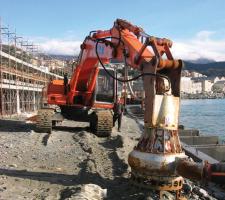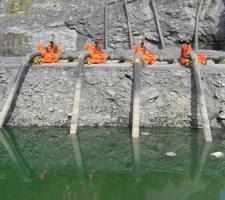
New pump technology is increasing flow rates, reaching greater heads and improving solids handling. ABE looks at the benefits for quarries
Managing drainage is an essential task in many European quarries as operators try to maximise reserves by extending below groundwater or coping with natural springs in the formation. These units not only allow for drier working conditions but also protect expensive equipment, so performance and reliability are key assets.
"Quarries want independent pumps that can work unchecked for sometime and are usually in the remotest part of the quarry," said
"Self-prime pumps are common in the UK but elsewhere in Europe submersible pumps are more popular as they are quieter and often more efficient," said
Submersible
According to Hörnschemeyer, the focus of recent submersible development has been on reducing costs of both initial investment and of ongoing maintenance. He said that Tsurumi has focused on improving maintenance with a better design that allows the checks to be carried out on-site rather than in a workshop.
Jägrén added, "Customers are always asking for us to extend the lifetime of the pump and minimise wear and use of the correct seals and maintenance are important to achieve this. Ease of maintenance is also an important consideration for customers.
"Our latest generation of pumps offers three time the service life due to improved technology and better impellors." Hörnschemeyer said, "Pumps used in quarries are working in a tough environment, so the designs for this sector are generally cast iron. This does make them heavy but at 22kW most pumps are heavy anyway and the cast iron is better able to cope with the solids. Our mechanical seals are completely protected in oil bars to help prolong life."
"Shovelling mud can be very difficult and time consuming using a wheeled loader or excavator but the pump system offers a continual flow." Toyo has also added an excavator mounted submersible pump to its product range in response to customer demand.
Self-prime
Some of the main pump developments in recent years have come from the self-prime sector with higher head pumps.
"In the past many quarries used to have to use stage pumps to remove water from the lowest points of a quarry, so in a 130m deep quarry, there would be a need to develop a ledge with a tank and second pump to remove the water," said
"Although this does mean larger engines, as horsepower determines pumping capacity, it means there is only one unit to maintain and a single set of wear parts, plus no need for a storage tank either. It is now possible to pump up to 200m with one pump which is pretty impressive, especially with a flow rate of 9,400litres/min." Godwin will be launching a new 200m high head pump - the HL260 - at
On the subject of other changes to the pumping market, Paz said that the impact of Stage IIIB engines will influence the sector. "The cost of engines will go up and I think there will be some shift towards used equipment as operators try to maintain the some similarity across fleets," he said. "However, carbon dioxide emissions are a big deal for customers - many have to account for it and are looking to drive down their liability."
One of the new trends is use of GPS and telemetry. The development is not finished yet - although systems are commercially available, they are generally perceived to be difficult to use or the technology is not accepted yet. But they have the potential to add real value and the development is underway now so I expect GPS to become much more widely used by this time next year.
Best practice
Although pumps themselves are relatively low cost items in comparison to some quarrying equipment, but managing site water is important to protect the high cost items. Nonetheless, many quarries do not protect their pumps from damage, which is putting other parts of the production at risk should the pump fail, or simply don't specify the right pump for the job.
"One of the biggest areas where there is room for improvement is in use of pumps on site," said Hörnschemeyer. "Although some of the advice we offer is very basic, we still see many site where it isn't followed. Such issues include lack of protection around a pump in areas where rock falls are possible - a simple metal cage can protect the pump and allow it to continue working.
"Lack of cable insulation is another common problem and means the cables are exposed to equipment trafficking over them. These are simple protection measures yet they are often ignored." Jägrén added, "The basic problem that still exists is that customers do not calculate the friction loss in the pipes, so often under specify the pump they need. They try to save energy by going for a smaller pump as they believe it will be cheaper to run but in the long term it is less efficient.
"Too many users wait for breakdown rather than scheduling serving and they should consider investing in a second pump to allow for regular maintenance without interrupting operations."RSS
















